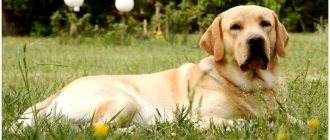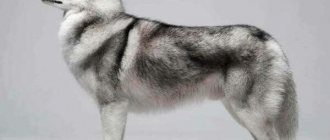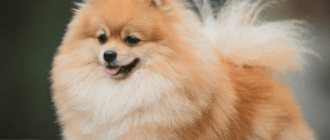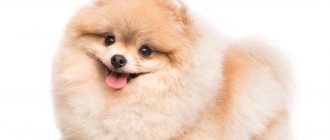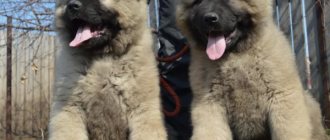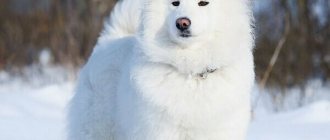Initially, Shar Peis were fighting dogs, but in our time they make excellent guards and watchmen.
At first glance, the breed seems funny, but hidden beneath the funny folds is a noble character and a sharp mind.
The Shar Pei is also distinguished by incredible strength and courage.
He is devoted to his master and will never leave him in trouble.
In this article we will talk about what size an adult Shar Pei can be - how much it weighs and how tall it is, as well as how a puppy should normally develop.
History and origin
The first mentions of dogs similar to Shar Pei (English Shar-Pei) are found in historical documents dating back to 206 BC. Dogs with a similar exterior and genotype have lived in China for centuries.
Animals were popular not only among Chinese emperors and members of famous dynasties, but also among peasants. Dogs guarded houses and helped in hunting. Lovers of cruel entertainment used them in dog fights. The peak of popularity occurred in the 30s.
The situation changed when the Communist Party came to power. Politicians felt that keeping animals in the house was an unjustified luxury. Mao Zedong ordered the merciless extermination of pets.
During World War II, the breed was on the verge of extinction. In the 50s, several purebred litters were found in China, and only in 1971 were Shar Peis brought to “Novaya Zemlya”. Animals with unusual appearance immediately attracted the attention of breeders and breeders, who decided to revive and restore the unique species. Only decades later did the gene pool return to normal.
The first purebred pedigree and official standard were approved in 1976. In 1978, the breed was listed in the Red Book. Shar Peis appeared on Russian territory in the early 90s.
Character
Having decided to become the owner of a Shar Pei, it is worth remembering that initially this is a fighting dog, therefore, without early socialization, it can grow up to be aggressive and vicious. Shar Peis are infinitely loyal to their owner and other family members, but do not get along well with other dogs. They treat other pets quite loyally. The dog will be happy to play with children if he gets used to their company as a puppy, but it is better not to leave such dogs alone with children. Outsiders are treated negatively. They are excellent guards and defenders of their territory; a puppy must be accustomed to guests from an early age, otherwise the pet’s protective instincts will later cause owners a lot of problems.
Shar Peis are very intelligent, quick-witted and calm. Despite the fact that they do not take well to separation from their owner, they can be left at home without fear that the dog will begin to spoil things. It’s still not worth leaving a Shar Pei alone for a long time; he needs attention and communication. The owner of a Shar Pei must be a person with a strong character in order to be able to prove his leadership to the dog. In terms of the degree of independence in decision-making in the desire to become the leader of the pack, this breed is second only to Caucasians.
Despite their harsh appearance, Shar Peis are kind, affectionate and understanding. They have a developed intellect, are excellent at finding the weak points of household members and skillfully using them. They will always be guided by their own opinion when making decisions; you need to have iron patience and self-control in order to become a real master for your Shar Pei.
Description of the breed
Appearance and standards
Shar Peis belong to the medium-sized Molosser group, a subgroup of the Molossian Mastine-like dogs. The wrinkled body and head give it an unusual appearance.
Body build: strong, proportional, with well-developed muscles. Compact back, flat croup, wide chest, muscular sloping shoulders.
Limbs: hind and front legs are widely spaced, well developed, muscular, with strong bones.
Tail: Thick and round, with a slightly tapered tip. Set on high, curled to one side or over the back.
Neck: wide, medium length. The muzzle is wide from the base of the skull to the tip of the large nose. The lobe is black or matches the main color of the coat.
Head: large, skull wide, flat. The ears are small, set high, dense, and triangular in shape. The tips of the ears are directed forward and slightly rounded.
Eyes: almond-shaped, medium size, dark in color, deep set. The look is expressive, but “gloomy”.
The mouth is dark purple in color, with some varieties being pink-spotted. In dilute colors with no black pigmentation, the tongue is lavender. The bite is correct, scissor-shaped.
Color: Any solid coat color except white is acceptable. The muzzle and back may be darkened.
Coat: Coarse, short and straight. The length of the guard hair does not exceed 2–2.5 cm. It fits tightly to the body near the limbs. There is no undercoat. Based on the type and structure of wool, there are two types:
- Horse - hair that resembles bristles, dense, up to 1 cm long.
- Brush - the spine is elastic, but soft and thick, 1–2.5 cm long.
Weight: females - 19-25 kg, males - 25-33 kg. Height - from 45 to 50 cm. Shar Pei grow intensively up to 7-8 months. Males are heavier in size than females, with a more square build.
With proper care, the average life expectancy at home is 10–13 years.
Temperament
Behind the pretty appearance of Shar-Peis lies a stubborn disposition, so people with a strong character should get them. They know how to analyze, “lead” and lead. If the necessary behavioral skills are not instilled in time, the dog will begin to show disobedience and independence from puppyhood.
These are not couch pets, but representatives of fighting breeds. Despite this, they love small children, are not aggressive towards other pets and rarely show aggression on the street.
Dimensions of an adult dog depending on gender
Weight of an adult Shar Pei depending on gender:
| Floor | Weight |
| Female | 18-25 kg |
| Male | 25-30 kg |
The Shar Pei breed standard states that there is no clear division in size for females and males. Dogs have the same limits in growth. It ranges from 46 cm to 51 cm.
For this reason, girls and boys Shar Pei are quite difficult to distinguish from each other, because they look almost the same.
Expert opinion
Tolkachev Andrey Mikhailovich
veterinarian
“On average, dogs, regardless of gender, weigh about 25-27 kg. An adult male dog may weigh more if the owner is focused on building muscle mass, and the weight of an adult female may increase after giving birth and while feeding puppies. Regarding height, it does not differ among Shar Pei individuals by gender. Both males and females are characterized by the same height at the withers. Of course, there may be differences, but they are determined by genetic characteristics, and not by gender.”
Maintenance and care
Due to their small size, Shar Peis are suitable for living conditions in city apartments. They do not shed and do not have a specific “dog” smell. The main condition is daily long walks. Without sufficient physical activity, the dog will become mischievous.
When kept in the private sector, arrange a spacious, warm enclosure or a private place with a good view so that the dog can perform its security functions. Do not place the enclosure in direct sunlight or in a windy area. Don't forget that these dogs have no undercoat.
Brush the coat with special massage brushes two to three times a week. Take care of the hygiene of your eyes, ears, and mouth. Inspect and clean the skin under the folds with a damp cloth.
Bathe no more than three times a year using pet shampoo. After water procedures, wipe your body with a terry towel and dry the folds with a hairdryer. To prevent diaper rash and irritation, use special talc or baby powder.
Every 3–4 months, carry out preventive deworming using complex anthelmintic drugs.
Treat the wool with insectoacaricidal drops, sprays, aerosols against fleas and other external parasites. Consult with experienced manufacturers before purchasing protective equipment.
Do not neglect preventive immunizations and revaccinations. The veterinarian will prescribe the optimal regimen.
Features of Shar Peis
If we take the average generally accepted standard, we can highlight the following features of the breed:
- The coat has large folds, the head is large in relation to the body;
- Small dark eyes set deep;
- Broad chested, medium size, square in shape, strong build;
- The triangular-sized ears fit tightly to the square head;
- A small thick tail curled over the back;
- The coat color is monochromatic.
Feeding
Shar Peis can be fed natural food or prepared dry and canned food. The diet should be nutritious and balanced in the content of proteins, fats, vitamins, amino acids necessary for normal development and health.
With a natural diet, the dog needs to receive lean meats, fermented milk products, boiled, stewed and fresh vegetables and fruits. Cook porridges in meat broth - oatmeal, rice, buckwheat. A piece of hard cheese, biscuits, dry unsweetened cookies, and “sugar” seeds are suitable as a delicacy. Supplement your diet with comprehensive vitamin/mineral supplements and probiotics to strengthen your immune system.
Video: battle with frozen strawberries
Peppered, spicy and salty dishes, fatty and smoked foods, baked goods and sweets, tomatoes are contraindicated. Do not feed offal, river fish, or meat of questionable quality that has not been heat treated. Do not give pork, tubular, or fish bones.
Puppies 4–9 months old are fed 2–3 times a day. After a year you can switch to one meal a day. Follow the schedule - feed at the same time. Food should be fresh, at room temperature. Make sure there is always drinking water in the bowl and change it every day.
Organize a place for feeding, purchase a special height-adjustable tripod for bowls. After each meal, wash dishes under running water.
What to do if your weight is below normal?
To understand what to do if a puppy’s weight lags behind the norm, you first need to find out the reason for this lag. It is better to establish this reason with the help of a veterinarian at a veterinary clinic. After the origins of such a deviation are clear, he will prescribe a special treatment, which should start the metabolic process with renewed vigor.
Treatment options may include:
- If the lag in weight is due to early weaning from the mother, as well as from a lack of fat, protein and carbohydrates, then vitamin D, meat and bone meal are prescribed;
- The lag may also be due to parasites. In this case, the puppy will have to be treated for them and undergo deworming and special vaccinations;
- Review your dog's diet. It is possible that it is not fully balanced or of poor quality. The reason for thinness may be that you often change food or feed your dog both natural food and industrial food. Pick one thing;
- There is no need to feed your pet human food, the same as what you prepare for yourself. Remember that the animal must have a separate menu.
You will also need to measure your dog's weight more frequently to ensure it is monitored closely.
Choose only high-quality products for feeding your dog, as well as premium and super-premium food.
NOTE!
If you see that your pet is reluctant to eat, do not rush to change food; it is possible that your dog is simply picky. Don't give her any treats during the day, and you will see how in the evening she will eat - with a completely different appetite.
Upbringing
Shar Peis are characterized by a stubborn disposition, so it is important to properly socialize the puppy from an early age. The first commands and correct behavioral manners need to be taught from a young age, as soon as the period of adaptation to the new environment has passed. Don't encourage "bad" habits. It is almost impossible to wean an adult dog from bad manners.
Video: excavations on the bed
To avoid problems communicating with other animals, teach your puppy to play together with them. Stop aggression towards strangers and animals. If you miss this moment, the adult dog will feel superior, impunity and may get out of control, which will result in serious problems.
Start basic training at 2–3 months. Nurture at an early age will soften dominant character traits. Be persistent, but do not punish disobedience. Harsh physical force is unacceptable. For following commands, reward your dog with treats and approving intonations, this will help develop the necessary reflexes. If classes are held with an instructor, consolidate the acquired skills yourself.
Disease susceptibility
Like any other breed, Shar Peis can be predisposed to certain health problems. Shar-Pei fever (FSF - Familiar Shar-Pei Fever) is a genetically inherited disease that usually affects animals bred through inbreeding; it usually appears before the age of 2-3 years. This disease must be diagnosed and treated by a veterinarian; the owner can only go to the veterinary clinic if the pet is unwell (refusal of food, lethargy, swelling of the joints, high body temperature).
Increased skin sensitivity is also common in Shar-Peis, since a large number of skin folds contribute to damage to the skin due to friction, causing diaper rash and inflammation. It should be remembered that any damage to the skin can cause significant discomfort to your pet, so when grooming or playing with your dog, pay attention to the condition of the skin. If your dog has redness, rashes or scratches on his skin, this is a reason to take him to the veterinarian. The doctor will determine the cause and prescribe treatment if necessary, and will also give advice on nutrition. To prevent skin diseases and maintain healthy coats, both puppies and adult Shar Peis need specific nutrition, such as the Purina® PRO PLAN® diet for dogs with sensitive skin with OPTIDERMA® complex.
Health
With proper care, Shar Peis have good health and strong immunity. But they are still susceptible to viral-bacterial, parasitic diseases and infections throughout their lives.
An unbalanced diet can lead to the development of food allergies. It manifests itself as skin itching, rash, indigestion, salivation, lacrimation or other uncharacteristic symptoms.
Dermatoses, dermatitis, demodicosis, seborrhea, pyoderma, eczema, and other dermatological diseases of various etiologies and genesis are often diagnosed. With improper skin care, pathogenic microorganisms and fungi multiply in the folds of the body, causing acute inflammation in various structures of the dermis.
Representatives of this breed are susceptible to ophthalmological diseases, including prolapse and entropion of the eyelid, conjunctivitis, glaucoma, cataracts, and keratitis (inflammation of the cornea).
The skin hangs over the eyelid and rubs the cornea, which leads to its damage and the appearance of ulcers. In this case, special brackets are used to lift the folds of skin upward. The operation is prescribed for most high-born puppies.
Shar Peis are also susceptible to endocrinological pathologies (hypoteriosis), otitis media, hip and elbow dysplasia, and renal amyloidosis.
Prohibited Products
It is important to exclude prohibited foods from your Shar Pei puppy’s diet:
- Bones, pure fat, skin, especially poultry.
- Palm oil.
- Grapes, raisins.
- Soy.
- Mushrooms.
- Corn and semolina.
- Raw freshwater fish.
- Dry, salted fish.
- Products containing sugar or sugar substitutes.
- Products containing xylitol (chewing gum, some sweets).
- Products containing flour or yeast.
- Products containing caffeine, cocoa, any stimulants (sweets, tea, coffee, chocolate).
- Products containing marinades, salt, spices.
- Smoked products, including sausages, balyki, fish.
- Expired products.
- Leftovers from the table.
Controversial foods in the diet of a Shar Pei puppy are:
- Lean raw pork.
- Raw ocean fish.
- Whole milk.
- Honey.
- Chicken eggs.
- Raw and boiled chicken liver in large quantities.
If your Shar Pei puppy is allergic, it is better to immediately exclude all controversial foods that contain allergens from the diet.
You should try introducing foods to which individual sensitivity may occur into your diet. If your Shar Pei puppy does not experience diarrhea or other severe reactions, they can be left on the menu permanently.
Choosing a puppy and cost
It is recommended to purchase 2-3 month old puppies from trusted breeders or specialized nurseries that will provide certificates and documents.
Pay attention to the behavior, appearance of newborn puppies, and the condition of the mother dog. Evaluate the breeder's living conditions for the animals. Find out what vaccinations you have received.
Healthy puppies are active, playful, and curious. They have shiny fur, clean, clear eyes, a moist nose, good appetite, and normal coordination of movements.
There should be no bald spots on the body, a large number of folds on the paws, in the tail area, or congenital defects. The baby should not show aggression towards people or be afraid.
The cost of purebred Shar-Pei varies from 8 thousand rubles for a dog without documents and up to 40 thousand for kids with a pedigree and parents who are champions of prestigious canine exhibitions.
How to measure height correctly?
To correctly measure a dog's height, you first need to find its withers.
A dog's withers are the highest point of the body. Measurements are taken at the withers regarding the growth of the animal. It is necessary to know the size at the withers in order to monitor the maturation of the pet, as well as to select the correct ammunition for it.
The dog's withers are located almost immediately behind the neck. It is the initial part of the back, which is located between the shoulder blades of the animal. In appearance, the withers look like a small tubercle. You can easily feel it, because it rises without effort, and is soft and elastic to the touch. It is by the withers that the bitch carries her puppies from place to place.
Once you have found the withers, you can measure the dog's height.
To correctly measure the size of an animal, you will need:
- Bring the dog to a calm state. She should stand straight, and it is better not to feed her before measuring;
- Let the dog become familiar with the measuring tools so as not to cause him anxiety;
- Place the dog on a flat surface - a flat floor or table;
- Make sure that the animal’s limbs are not tense, but relaxed.
After this you can take a measurement:
- Place a book, construction meter, ruler or any other flat object on the animal’s shoulder blades;
- With a second measuring object - this could be a meter or a second ruler - measure the distance from the floor to the dog's withers. This value will be the size of your pet.
NOTE!
To be sure that the measurement was taken correctly, you can do it several times at some intervals.
